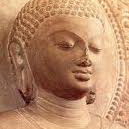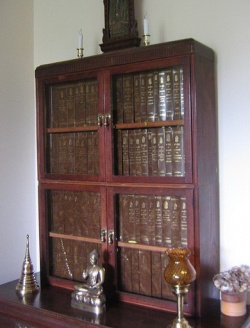Pali literature
Pali literature is concerned mainly with Theravada Buddhism, of which Pali is the traditional language.India
The earliest and most important Pali literature constitutes the Pāli Canon, the scriptures of Theravada school. These are mainly of Indian origin, and were written down during the Fourth Buddhist Council in Sri Lanka in 29 BCE, approximately four hundred and fifty four years after the death of the Buddha.
The Pāli Canon (Tripitaka) is divided into three pitakas (from Pali piṭaka, meaning "basket"). The three pitakas are:
Vinaya Pitaka ("Discipline Basket"), dealing with monastic rules
Sutta Pitaka ("Sutra/Sayings Basket"), discourses, mostly ascribed to the Buddha, but some to disciples
Abhidhamma Pitaka,("About Dhamma Basket") Various later philosophical and psychological works.
Sri Lanka
Sri Lanka became the headquarters of Theravada for centuries, and most Pali literature in this period was written there, though some was also produced in outposts in south India. After a gap following the completion of the canon in which little or no Pali literature was produced, it restarted with the Dipavamsa, a verse chronicle of Buddhism in India and Ceylon, followed by a similar, but longer, work, the Mahavamsa. An important text is Buddhaghosa's Visuddhimagga, which came to be regarded as the standard summary of the traditional interpretation of the scriptures, in the fourth or fifth century. Buddhaghosa also compiled commentaries on much of the Canon, work continued by his successors, who also produced subcommentaries on many commentaries, and sometimes even sub-subcommentaries. There were also handbooks summarizing some aspects of the teachings, and other literature, all or nearly all concerned with Buddhism, at least ostensibly. From the early thirteenth century the writing of Pali literature in Sri Lanka went into a steep decline, though it never ceased entirely. Instead, Buddhist literature was written in Sinhalese.
List of post-canonical Pali texts
Quasi-canonical texts in the Khuddaka Nikaya of the Burmese Tipitaka but not in the Thai or Sri Lankan:
Nettipakarana and Petakopadesa - "The Book of Guidance" and "Instruction on the Pitaka"
Milindapañha - The Questions of King Milinda
Commentarial literature:
Atthakatha - Commentarial works by Buddhagosa, Dhammapala, Mahanama, Buddhadatta & others
Tika - Sub-commentarial works
Historical chronicles:
Dipavamsa - "The Island Chronicle" (4th c.)
Mahavamsa - Mahanama; "The Great Chronicle" (6th c.)
Culavamsa - "The Lesser Chronicle"
Vamsatthappakasini - Commentary of the Mahavamsa (6th c.)
Mahabodhivamsa - Upatissa, Account of the bodhi tree of Anuradhapura(11th c.).
Thupavamsa - Vacissara, A chronicle of the Great Stupa in Anuradhapura (12th c.)
Dathavamsa - Dhammakitti, A poem on the sacred Relic of the tooth of the Buddha.
Samantakutavannana - Vedehathera, A poem in 796 stanzas on the Buddha's life and his visits to Sri Lanka.
Hatthavanagalla-viharavamsa - Life story of the Buddhist king Sirisanghabodhi (r. 247-249) of Anuradhapura (13th c.)
Saddhamma-sangaha - Dhammakitti Mahasami, Literary and ecclesiastical history of Buddhism (14th c.)
Cha-kesadhatuvamsa - A history of the six stupas that enshrine the hair relics of the Buddha. (14th c.)
Gandhavamsa - Catalog of ancient Buddhist commentators (19th c.)
Sāsanavaṃsa - Paññasamin, A Burmese history of Buddhism (19th c.)
Biographies:
Jinalankara - Buddharakkhita, 278 verse poem on the life of the Buddha (12th c.)
Anagata-vamsa - Mahakassapa of Cola, Story of Maitreya, the next Buddha (12th c.)
Jinacarita - Medhankara, 472 verse poem on the life of the Buddha (13th c.)
Pajjamadhu - Buddhapiya Dipankara (13th c.), poem on the beauty of the Buddha
Jinakalamali - Ratanapañña, Account of the life of the Buddha (16th c.)
Braḥ Māleyyadevattheravatthuṃ - SE Asian narrative of the travels of the monk Māleyyadev.
Buddhaghosuppatti - Mahāmaṅgala, Story of Buddhagosa (Burma, 15th c.)
Jinavamsadipani - Moratuve Medhananda Thera, An epic poem on the life of the Buddha & his teachings in 2000 verses (1917)
Mahakassapacarita - Widurapola Piyatissa, 1500 verse poem on the life of Mahakasyapa (1934)
Abhidhamma manuals & treatises:
Abhidhammavatara - Buddhadatta, "The earliest effort at systematizing, in the form of a manual, the doctrines dealt with in the Abhidhamma" (5th c.)
Ruparupa-vibhaga - Buddhadatta - A "short manual on Abhidhamma" (5th c.)
Saccasankhepa - Culla-Dhammapala, "Elements of Truth", A "short treatise on Abhidhamma" (7th c.)
Abhidhammattha-sangaha - Acariya Anuruddha, A summary of the Abhidhamma, widely used as an introductory text. Modern English translation available by Bhikkhu Bodhi (A Comprehensive Manual of Abhidhamma, 1993).
Namarupa-pariccheda - Acariya Anuruddha, A verse introduction to the Abhidhamma.
Paramattha-vinicchaya - Acariya Anuruddha.
Khemappakarana - Khema, A "short manual on the Abhidhamma."
Mohavicchedani - Mahakassapa of Cola, A guide to the matikas (topics) of the seven books of the Abhidhamma (12th c.)
Nāmacāradīpikā - Chappata, (15th c.)
Miscellaneous:
Saddanīti - Aggavaṃsa of Arimaddana, An influential Pali grammar text; Burma, A.D. 1154.
Vimuttimagga - A short practice manual by Upatissa (1st c.)
Visuddhimagga - Buddhaghosa, A very influential meditation manual (5th c.)
Vinayavinicchaya - Buddhadatta, A verse summary of the first four books of the Vinaya (5th c.)
Uttaravinicchaya - Buddhadatta, A verse summary of the Parivara, the final book of the Vinaya (5th c.)
Paramatthamañjusa - Dhammapala, Commentary on the Visuddhimagga (6th c.)
Khuddasikkha and Mulasikkha - Short summaries on monastic discipline.
Upasaka-janalankara - Sihala Acariya Ananda Mahathera, A manual on the Buddha's teachings for laymen (13th c.)
Sarasangaha - Siddhattha, A "manual of Dhamma" in prose and verse (13th c.)
Sandesakatha and Sima-vivada-vinichaya-katha (Burma, 19th c.)
Pañcagatidipana - A poem that describes the five forms of rebirth.
Saddhammopayana - 629 short verses in praise of the Dhamma.
Telakaṭāhagāthā - "The Oil-Cauldron Verses.", Collection of Sri Lankan poems from a monk thrown into boiling oil.
Cakkavaladipani - Sirimangala, A text on Buddhist cosmology (1520)
Dasabodhisattuppattikatha - Birth Stories of the Ten Bodhisattas.
Bhesajjamanjusa - Medical text, Sri Lanka (13th c.)
Yogāvacara's Manual - Sri Lankan meditation manual
The progress of insight - Mahasi Sayadaw, originally in Burmese, translated to Pali (1950)
Burma
From the fifteenth century onwards, Pali literature has been dominated by Burma, though some has also been written in Thailand, Laos and Cambodia, as well as Ceylon. This Burmese literature has in turn been dominated by writings directly or indirectly concerned with the Abhidhamma Pitaka, the part of the Canon variously described as philosophy, psychology, metaphysics etc.



